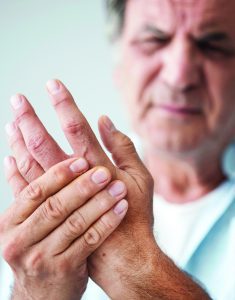Why is physical activity important for people with arthritis?


How much activity do I need?
Stay as active as your health allows, and change your activity level depending on your arthritis symptoms. Any physical activity is better than none.
Start low, and go slow
When starting or increasing physical activity, start slow and pay attention to how your body tolerates it. People with arthritis may take more time for their body to adjust to a new level of activity. If you are not active, start with a small amount of activity, for example, 3 to 5 minutes 2 times a day. Add activity a little at a time (at least 10 minutes at a time) and allow enough time for your body to adjust to the new level before adding more activity.
Modify activity when arthritis symptoms increase, try to stay active.
Your arthritis symptoms, such as pain, stiffness, and fatigue, may come and go and you may have good days and bad days. Try to modify your activity to stay as active as possible without making your symptoms worse.
Activities should be “joint friendly.”
Choose activities that are easy on the joints like walking, bicycling, water aerobics, or dancing. These activities have a low risk of injury and do not twist or “pound” the joints too much.
Recognize safe places and ways to be active.
Safety is important for starting and maintaining an activity plan. If you are currently inactive or you are not sure how to start your own physical activity program, an exercise class may be a good option. If you plan and direct your own activity, find safe places to be active. For example, walk in an area where the sidewalks or pathways are level and free of obstructions, are well-lighted, and are separated from heavy traffic.
Talk to a health professional or certified exercise specialist.
Your doctor is a good source of information about physical activity. Health care professionals and certified exercise professionals can answer your questions about how much and what types of activity match your abilities and health goals.
What types of activities should I do?
How hard are you working?
Measure the relative intensity of your activity with the talk test. In general, if you’re doing moderate activity you can talk, but not sing, during the activity. If you are doing vigorous activity, you will not be able to say more than a few words without pausing for a breath.
Low-impact aerobic activities do not put stress on the joints and include brisk walking, cycling, swimming, water aerobics, light gardening, group exercise classes, and dancing.
For major health benefits, do at least:
• 150 minutes (2 hours and 30 minutes) of moderate-intensity aerobic activity, like cycling at less than 10 miles per hour, or
• 75 minutes (1 hour and 15 minutes) of vigorous-intensity aerobic activity, like cycling at 10 mph or faster, each week. Another option is to do a combination of both. A rule of thumb is that 1 minute of vigorous-intensity activity is about the same as 2 minutes of moderate-intensity activity. Aerobic activity can be broken into short periods of 10 minutes or more during the day.
In addition to aerobic activity, you should also do muscle-strengthening activities that involve all major muscle groups two or more days a week.
Muscle-strengthening exercises include lifting weights, working with resistance bands, and yoga. These can be done at home, in an exercise class, or at a fitness center.
Flexibility exercises like stretching and yoga are also important for people with arthritis. Many people with arthritis have joint stiffness that makes daily tasks difficult. Doing daily flexibility exercises helps maintain range of motion so you can keep doing everyday things like household tasks, hobbies, and visiting with friends and family.
Balance exercises like walking backwards, standing on one foot, and tai chi are important for those who are at a risk of falling or have trouble walking. Do balance exercises 3 days per week if you are at risk of falling.
What do I do if I have pain during or after exercise?
It’s normal to have some pain, stiffness, and swelling after starting a new physical activity program. It may take 6 to 8 weeks for your joints to get used to your new activity level, but sticking with your activity program will result in long-term pain relief.
Here are some tips to help you manage pain during and after physical activity so you can keep exercising:
• Until your pain improves, modify your physical activity program by exercising less frequently (fewer days per week) or for shorter periods of time (less time each session).
• Try a different type of exercise that puts less pressure on the joints—for example, switch from walking to water aerobics.
• Do proper warm-up and cool-down before and after exercise.
• Exercise at a comfortable pace—you should be able to carry on a conversation while exercising.
• Make sure you have good fitting, comfortable shoes.
See your doctor if you experience any of the following
• Pain that is sharp, stabbing, and constant.
• Pain that causes you to limp.
• Pain that lasts more than 2 hours after exercise or gets worse at night.
• Pain or swelling that does not get better with rest, medication, or hot or cold packs.
• Large increases in swelling or your joints feel “hot” or are red.
Source: CDC
 Southwest Florida's Health and Wellness Magazine Health and Wellness Articles
Southwest Florida's Health and Wellness Magazine Health and Wellness Articles

